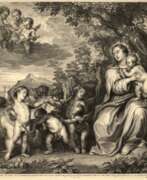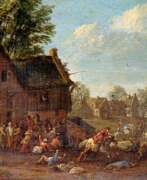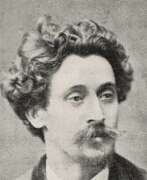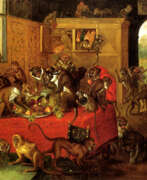Landscape painters Flanders




Schelte Adamsz Bolswert was a leading Dutch engraver, noted for his works after Rubens and Van Dyck. Both he and his older brother, Boetius à Bolswert, worked in Amsterdam and Haarlem before settling in Antwerp. For the last five years of his life Boetius worked exclusively on engravings after Rubens. Bolswert's plates were worked entirely with the graver, and he does not seem to have made any use of the drypoint. The freedom which this excellent artist handled the graver, the picturesque roughness of etching, which he could imitate without any other assisting instrument, and the ability he possessed of distinguishing the different masses of colours, have always been admired by the conoisseurs".




Pieter Brueghel the Younger was a Flemish artist celebrated for his detailed landscapes, religious themes, proverbs, and vibrant village scenes. Despite being the son of the illustrious Pieter Bruegel the Elder, Brueghel the Younger carved out his own niche in the art world, earning the moniker 'Hell Brueghel' for his dynamic scenes of fires and energetic copies of his father's peasant life portrayals.
Brueghel the Younger's original creations, such as "The Village Lawyer," showcase his keen observation of village life, merging the energy and boldness of 17th-century style with his father's idiom. His work is characterized by its lively, picturesque depiction of peasants, albeit some critics argue they lack the subtlety and humanism of his father's creations. Despite this, Brueghel the Younger's legacy includes a significant number of original works and copies that were rediscovered in the 20th century, highlighting his contribution to the Flemish painting tradition.
His workshop was known for its prolific output, especially in producing copies of Bruegel the Elder's compositions, a testament to the enduring popularity and influence of the Bruegel family's artistic legacy. However, Brueghel the Younger also impressed with his unique compositions, contributing to the genre of still life and village scenes with a distinct style that resonated well into modern times.
For collectors and experts in art and antiques, Pieter Brueghel the Younger's works represent an important period in Flemish art, offering insights into the evolution of genre painting and the detailed portrayal of rural life. His paintings, held in esteemed collections worldwide, continue to be studied and admired for their vibrancy, narrative quality, and historical value.
To explore more about Pieter Brueghel the Younger and to stay updated on sales and auction events related to his work, signing up for specialized updates can offer exclusive insights into the world of this influential Flemish painter. This subscription ensures enthusiasts and collectors are well-informed about developments related to Brueghel the Younger's oeuvre, enhancing their appreciation and understanding of his artistic legacy.


Hendrik Frans de Cort was a Flemish landscape painter and draughtsman. In 1770 he became a master in the Antwerp Guild of Saint Luke. His early landscapes from the time before he moved to England were often made in collaboration with other Flemish artists. De Cort is known for his topographical views of English and Welsh landscapes. These were painted in an Italianate idiom indebted to the style of Gaspar Dughet. He often painted on specially prepared mahogany panels.


Louis Victor Antonio Artan de Saint-Martin was a Belgian marine painter. His work was influenced by the Barbizon School and the French marine painter Eugène Boudin. A convinced realist, he confined himself to the familiar North Sea, which he studied every day. He was fascinated by dramatic effects and exceptional atmospheric conditions. Just as in the paintings of the Tervuren school, his painting, created by the use of large quantities of pigment applied in copious layers or large masses skilfully distributed and then worked with a trowel, gives the work an appearance of breadth and immediacy.
Saint-Martin was one of the sixteen co-founders of the Société Libre des Beaux-Arts, an association opposed to the stylistic hegemony of the academies and salons. After 1880 he worked in a more impressionist style, and in 1881 he became a Chevalier de l'Ordre de Léopold. Two years later, the artist was awarded a gold medal at the International Colonial and Export Exhibition in Amsterdam.


Lucas van Valckenborch was a Flemish painter, mainly known for his landscapes. He also made contributions to portrait painting, and allegorical and market scenes. Court painter to Archduke Matthias, the governor of the Spanish Netherlands in Brussels, he later migrated to Austria and then Germany where he joined members of his extended family of artists who had moved there for religious reasons.


Jacques Fouquières, an eminent Flemish landscape painter active in the early 17th century, was celebrated for his detailed and atmospheric landscapes. Born around 1580 and active mainly in France, Fouquières's artistry flourished in a period rich in landscape painting. His style was heavily influenced by the Northern style prevalent during the late 16th and early 17th centuries, characterized by wide, panoramic landscapes with craggy rocks and a blue-greenish palette.
Fouquières's work was not just confined to painting; he was also a skilled draughtsman. His early works, like the "Winter Landscape" of 1617 in the Fitzwilliam Museum, showcase the influence of artists such as Joos de Momper, Jan Brueghel the Elder, Adriaen van de Venne, and Hendrick Avercamp. This particular painting is notable for its portrayal of a cold, wintry scene, exhibiting a mastery of the Northern landscape tradition. However, in his 1622 Forest Landscape, now in the Wallraf–Richartz Museum, Fouquières broke from this tradition, opting for narrower focuses and darker, more concentrated depictions of trees.
One of his notable works, "Landscape with ruins, people and animals," is preserved in The Metropolitan Museum of Art. This piece exemplifies Fouquières's talent in creating engravings, a medium that allowed him to capture intricate details of landscapes and everyday life.
His legacy extends beyond his works; he was a teacher to notable artists like Philippe de Champaigne and Matthieu van Plattenberg. Despite the success in his early career, his life ended in relative poverty, as evidenced by the modest inventory of his estate.
For collectors, auctioneers, and experts in art and antiques, the works of Jacques Fouquières represent a significant period in the history of landscape painting. His contributions to the art world during a pivotal era in European art history continue to be celebrated and studied.
If you have a keen interest in Jacques Fouquières's works or wish to stay informed about sales and auctions of his art, subscribing to updates would be beneficial. This will ensure you receive timely information about new sales and auction events related to his art.


Peeter Gijsels was a Flemish painter of the Baroque period.
Peeter Gijsels is known for his landscapes, architectural compositions and still lifes. He is also considered a genre painter as he painted scenes of village markets and church kermis. His landscapes in the style of Jan Bruegel the Elder were in great demand during his time.


Jacob Grimmer was a Flemish painter who was active during the Late Renaissance. He specialised in landscapes and genre scenes, often depicting the everyday life of peasants.
His style was strongly influenced by Pieter Bruegel the Elder and the works of Leonardo da Vinci and Raphael.
Grimmer's paintings are characterized by detailed, realistic depictions of nature. His landscapes are characterized by wide expanses and intricate detail.
Jacob Grimmer was known for his ability to capture the nuances of human behaviour, so his genre works depict the lives of peasants with a touch of humour and whimsy.


Frans Hogenberg was a Flemish and German painter, engraver, and mapmaker. He is known for portraits and topographical views as well as historical allegories. He also produced scenes of contemporary historical events. Hogenberg was the author of graphic works, engravings of city views and maps of the first four volumes of the six-volume atlas Theatrum Orbis Terrarum (Description and drawings of the most famous cities in the world), published in 1570 by the Flemish geographer Abraham Ortelius. Hogenberg's engravings are an invaluable source of information about urban development in medieval Europe.


Gijsbrecht Leytens was a Flemish landscape painter of the Early Baroque period. He was famous for his depiction of winter landscapes, which were considered his speciality and were characterised by a highly individualised style. He is considered one of the least studied Flemish painters of the Antwerp School.
Geisbrecht Leitens became a member of the Guild of Saint Luke in Antwerp in 1611. From that time he was entitled to open his own workshop in the city and train apprentices.
The master carefully observed winter nature and birds and developed an individual manner which distinguished him from the philosophical generalisations of Pieter Bruegel the elder or the cosy details and findings of Lucas van Falkenborgh. Trees in his paintings are usually depicted covered in snow, often oddly shaped. The branches of the denuded trees are replete with representations of various birds. The artist's creative style may have been influenced by paintings from the Dutch Mannerism period.


Jan Baptist Lodewyck Maes was a Belgian genre painter active in Italy. Maes studied at the Academy of Ghent. He exhibited for the first time at that city's fair in 1810. He won prizes in all the competitions he entered and in 1820 received a grant from the city of Ghent. Thanks to the Belgian Rome Prize received in 1821, he first visited Paris and then went on to Italy. In 1822 he copied works by old masters in the Uffizi Museum. In 1824 he settled in Rome. Maes kept in touch with his hometown and regularly sent works to Belgian salons. He was a corresponding member of the Royal Netherlands Academy of Sciences.


Herri met de Bles is a Flemish artist, along with Joachim Patinir, one of the founders of European landscape painting. He painted mainly landscapes with multi-figured compositions. Like Patinir, his style is characterized by stylized images of rocks and a careful rendering of aerial perspective.


Joos de Momper the Younger was a Flemish landscape painter active in Antwerp between the late 16th century and the early 17th century. Brueghel's influence is clearly evident in many of de Momper's paintings. His work is situated at the transition from late 16th-century Mannerism to the greater realism in landscape painting that developed in the early 17th century. He achieved considerable success during his lifetime.


Bonaventura Peeters the Elder was a prominent Flemish painter, draughtsman, and etcher specializing in marine art during the 17th century. His extensive body of work encompassed marine battles, storms at sea, shipwrecks, and views of ships in rivers and harbours.
Peeters displayed a keen understanding of ships, capturing their intricate details. His earlier works exhibited tonal landscapes influenced by Dutch painting, while later pieces reflected vibrant colors inspired by Italian classicism. He skillfully depicted dramatic shipwrecks, serene ports, and intricate portrayals of ships. Many of his paintings depicted actual locations along the North Sea and the river Scheldt, while others showcased imagined scenes of far-away Mediterranean and Middle Eastern ports. Peeters also collaborated with family members and fellow artists, and his drawings and engravings were included in notable publications like Blaeu's Atlas Maior.


Marten Rijckaert was a Flemish Baroque painter, famous for his landscapes in the Italian manner.
Marten Rijckaert was a pupil of Tobias Verhacht. He was registered as a master at the Antwerp Guild of St Luke's in 1607. Reikart was a close friend of Antonis van Dyck.
His work is characterised by rocky forest landscapes, often with waterfalls, ruins and architecture. These Italian landscapes are close to the works of Flemish painter Paul Brill, and the panoramic concept of his compositions owes a debt to the works of Jan Brueghel the Elder.




Jan Siberechts was a Flemish landscape painter whose career spanned both his native land and England. Initially, Siberechts developed a personal style of landscape painting in Antwerp, emphasizing Flemish countryside and country life. His work was influenced by Dutch Italianate landscape painters such as Nicolaes Berchem and Karel Dujardin, reflecting a blend of local and Italianate elements. This phase of his career was marked by vivid depictions of the Flemish rural life, with robust country girls in bright attire becoming a signature motif of his paintings.
Siberechts moved to England around 1672, where he significantly contributed to the English landscape tradition. In England, he painted decorations for the Duke's Cliveden House and later, traveled extensively, completing commissions for aristocratic clients. His English landscapes maintained their Flemish character but also started to focus more on universal themes, with less emphasis on figures and more on the scenery itself. These works are characterized by powerful trees, soft light on distant hills, and a relatively dark foreground to highlight the illuminated vistas in the background.
Siberechts is credited as the 'father of British landscape' for his pioneering country house portraits, blending detailed naturalistic views of stately homes into atmospheric landscapes. This innovative approach had a lasting influence on English landscape painting. His work, such as the views of Longleat and the Belsize Estate, represents an important step in the development of topographical painting, merging Flemish influences with the emerging English landscape tradition.
For collectors and experts in art and antiques, Siberechts' oeuvre offers a unique window into the transnational flow of artistic ideas in the 17th century, blending Flemish traditions with the nascent English landscape genre. His paintings, celebrated for their detail and historical topographical interest, can be found in prestigious collections such as the Tate Gallery London and the Victoria and Albert Museum.
For updates on exhibitions, sales, and auction events related to Jan Siberechts' work, art enthusiasts are encouraged to sign up for dedicated newsletters. This ensures that they remain informed about the latest opportunities to explore and appreciate the contributions of this influential Flemish artist to the landscape painting genre.


Pieter Stevens the Younger was a Flemish painter and draughtsman known for his landscapes. He left Flanders to work for the court of Emperor Rudolf II in Prague. The circulation of prints made after a series of romantic Bohemian landscape drawings by Stevens and other artists had an important influence on the development of Flemish and Dutch landscape art in the 17th century.


Hendrik van Cleve III was a Flemish painter, draughtsman and designer of prints. He is known for topographical views, including views of Rome and the Vatican, as well as imaginary landscapes. Traditionally, a large number of depictions of the construction of the Tower of Babel have been attributed to him but most of these are now attributed to anonymous Flemish painters, who are referred to as 'The Hendrik van Cleve III Group'.


Gillis van Coninxloo (now also referred to as Gillis van Coninxloo II but previously referred to as Gillis van Coninxloo III) was a Flemish painter of landscapes who played an important role in the development of Northern landscape art at the turn of the 17th century. He spent the last 20 years of his life abroad, first in Germany and later in the Dutch Republic.


Jacob van der Heyden was a Flemish Baroque painter, sculptor and engraver. According to Houbraken he was a painter from Strasbourg who painted for royalty. According to the RKD he worked in Strasbourg, Frankfurt, and Sweden. and was known for portraits, landscapes and historical allegories. Most of his work that survives today are engravings. He died in Brussels.




Izaak (Isaac) van Oosten was a Flemish Baroque landscape and cabinet painter active in Antwerp.
His landscapes are simple with open spaces and mostly hilly landscapes typically filled with a pond or road and several clusters of trees. There is an overall sense of gentleness and calm in these compositions. An even, gentle light spreads over the entire painting and the trees are untouched by the wind. A number of his landscapes have a Mediterranean flavour.
Works by van Oosten can be found in the collections of the Uffizi, the Museo del Prado, the Hermitage Museum, the Musée des Beaux-Arts d'Orléans, the Museum of Fine Arts of Rennes, the Toledo Museum of Art and other museums.




Ignatius Josephus van Regemorter was a Flemish historical, landscape, and genre painter and engraver. He studied under his father, Petrus Johannes, also in Paris, Antwerp, Brussels, and Ghent.

















